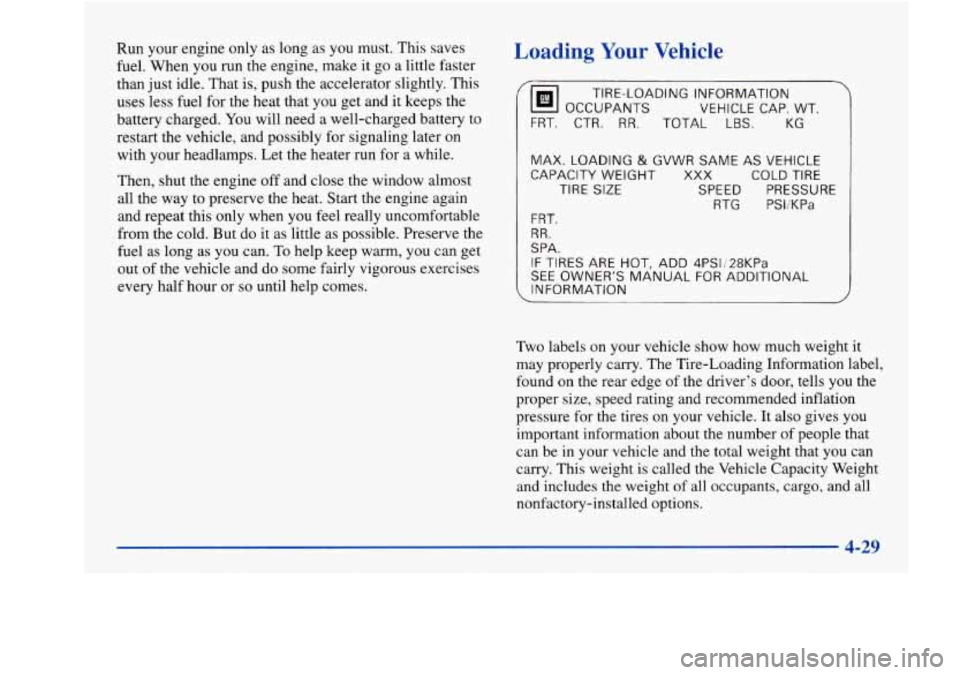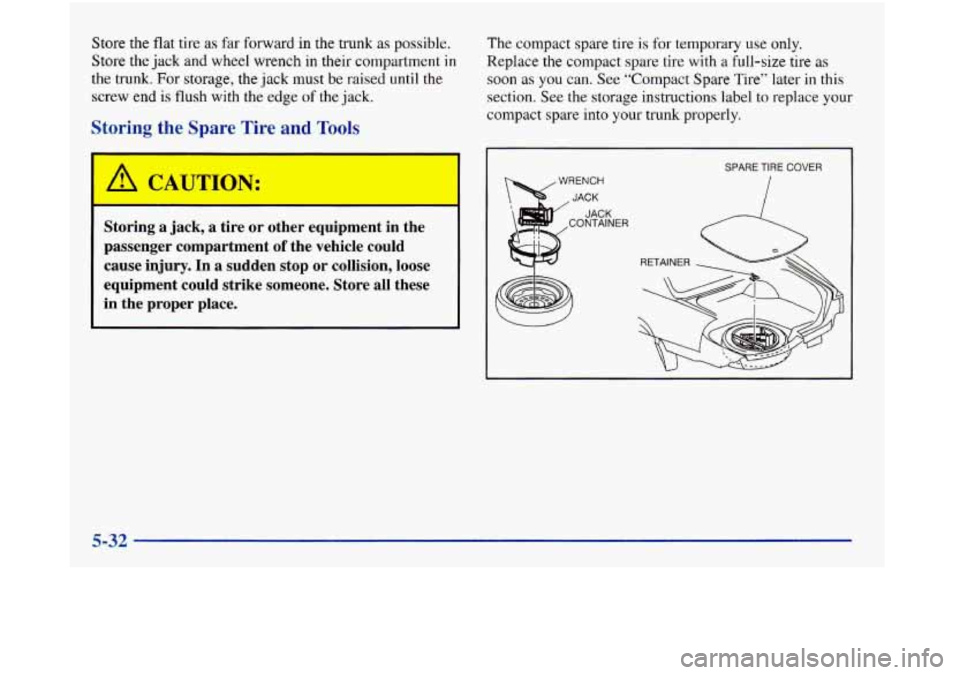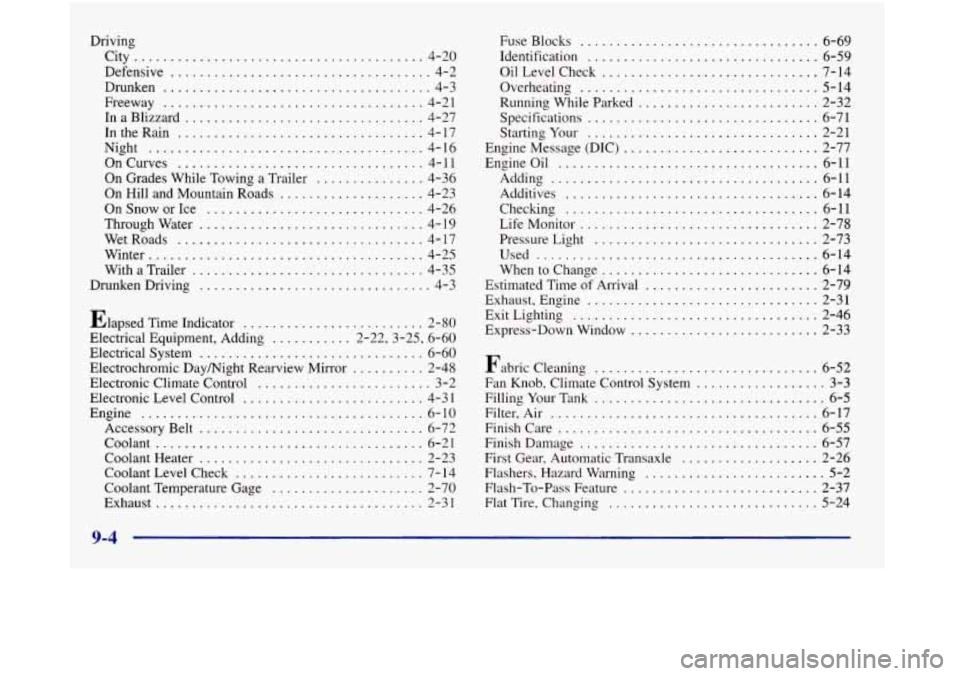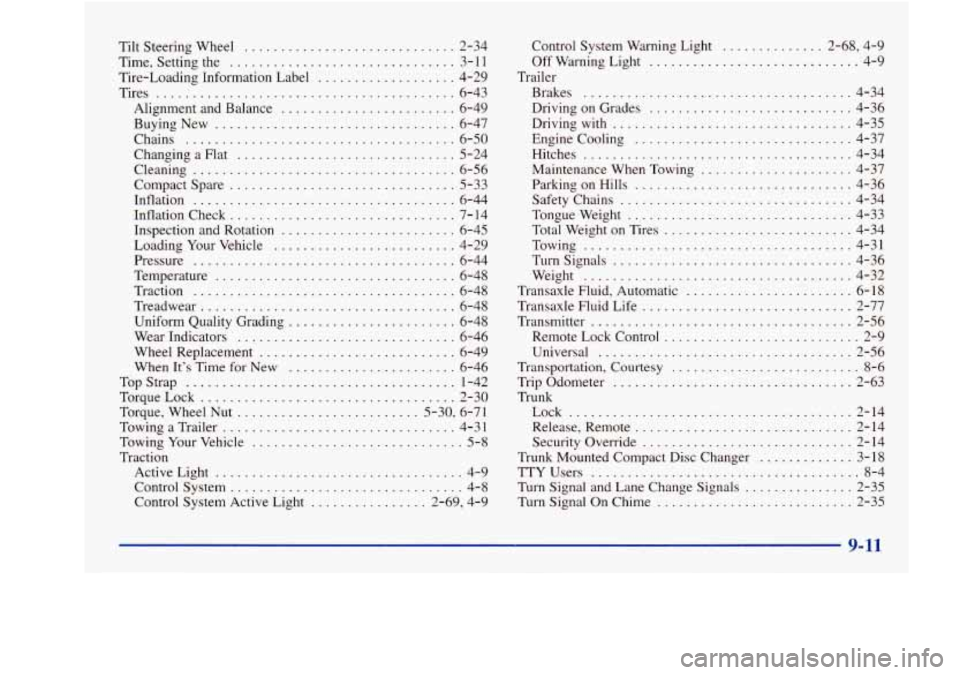run flat Oldsmobile Aurora 1998 Owner's Manuals
[x] Cancel search | Manufacturer: OLDSMOBILE, Model Year: 1998, Model line: Aurora, Model: Oldsmobile Aurora 1998Pages: 380, PDF Size: 19.75 MB
Page 7 of 380

@ The 1998 Oldsrnobile Aurora Owner’s Manual
1-1
2- 1
3-1
4-1
5-1
6-1
7- 1
8- 1
9- 1
Seats and Restraint Systems
This section tells you how to use your seats and safety belts properly. It also explains the “SRS” system.
Features and Controls
This section explains how to start and operate your vehicle.
Comfort Controls and Audio Systems
This section tells you how to adjust the ventilation and comfort controls and how to operate your audio system.
Your Driving and the Road
Here you’ll find helpful information and tips about the road and how to drive under different conditions.
Problems on the Road
This section tells what to do if you have a problem while driving, such as a flat tire or overheated engine, etc.
Service and Appearance Care
Here the manual tells you how to keep your vehicle running properly and looking good.
Maintenance Schedule
This section tells you when to perform vehicle maintenance and what fluids and lubricants to use.
Customer Assistance Information
This section tells you how to contact Oldsmobile for assistance and how to get service and owner publications.
It also gives you information on “Reporting Safety Defects” on page
8-8.
Index
Here’s an alphabetical listing of almost every subject in this manual. You can use it to quickly find
something you want to read.
i
Page 119 of 380

In front of the storage area is a cupholder. Press and
release the cupholder cover
to open. Push the cupholder
forward to lock it when in use. Press the cupholder back
to its recessed position when not in use.
Rear Storage Armrest
Your vehicle has a rear storage armrest with a
pass-through feature.
Pull down the bolster in the back seat to use the armrest
and two cupholders. Lift the top of the armrest for
storage space.
Pull down the interior door to access the trunk.
Convenience Net
Your vehicle has a convenience net just inside the back
wall of the trunk.
Put small loads, like grocery bags, behind the net. It can
help keep them from falling over during sharp turns or
quick starts and stops. The
net isn’t for larger, heavier loads. Store them in the
trunk as far forward as
you can. You can unhook the net
so that it will lie flat when you’re not using it.
Two positions exist for the convenience net, depending
on the size of the cargo.
Use this position for small loads.
2-53
Page 207 of 380

Run your engine only as long as you must. This saves
fuel. When you run the engine, make it go a little faster
than just idle. That is, push the accelerator slightly. This
uses less fuel for the heat that you get and
it keeps the
battery charged. You will need a well-charged battery to
restart the vehicle, and possibly for signaling later on
with your headlamps. Let the heater run for a while.
Then, shut the engine off and close the window almost
all the way to preserve the heat. Start the engine again
and repeat this only when you feel really uncomfortable
from the cold. But do it as little as possible. Preserve the
fuel as long as you can. To help keep warm, you can get
out of the vehicle and do some fairly vigorous exercises
every half hour or
so until help comes.
Loading Your Vehicle
Fhl OCCUPANTS
VEHICLE CAP. WT.
7
TIRE-LOADING INFORMATION
FRT. CTR. RR. TOTAL LBS. KG
MAX. LOADING & GVWR SAME AS VEHICLE
CAPACITY WEIGHT
XXX COLD TIRE
TIRE
SIZE SPEED PRESSURE
RTG PSliKPa
FRT.
RR.
SPA.
IF TIRES ARE HOT, ADD 4PSIj28KPa
SEE OWNER’S MANUAL FOR ADDITIONAL
INFORMATION
Two labels on your vehicle show how much weight it
may properly carry. The Tire-Loading Information label,
found on the rear edge
of the driver’s door, tells you the
proper size, speed rating and recommended inflation
pressure
for the tires on your vehicle. It also gives you
important information about the number of people that
can be in your vehicle and the total weight that you can
carry. This weight is called the Vehicle Capacity Weight
and includes the weight of all occupants, cargo, and all
nonfactory-installed options.
Page 247 of 380

I
NOTICE:
Improperly tightened wheel nuts can lead to
brake pulsation and rotor damage.
To avoid
expensive brake repairs, evenly tighten the wheel
nuts in the proper sequence and to the proper torque specification.
12. Then replace the wheel cover. Be sure to position
the alignment pin
on the cover with the notch in the
wheel. Apply pressure around the edge
of the cap to
snap it in place. Do not use a hammer or mallet to
install the cover.
Don’t try to put the wheel cover on the compact
spare tire. It won’t fit. Store the wheel cover in the
trunk
until you have replaced the compact spare tire
with a regular tire.
I NOTICE:
Wheel covers won’t fit on your compact spare. If
you try to put a wheel cover on your compact
spare, you could damage the cover or the spare.
Storing the Flat Tire and Tools
A CAUTION:
Storing a jack, a tire or other equipment in the
passenger compartment of the vehicle could
cause injury. In
a sudden stop or collision, loose
equipment could strike someone. Store
all these
in the proper place.
5-31
Page 248 of 380

Store the flat tire as far forward in the trunk as possible.
Store the jack
and wheel wrench in their compartment in
the trunk. For storage,
the jack must be raised until the
screw
end is flush with the edge of the jack.
Storing the Spare Tire and Tools
Storing a jack, a tire or other equipment in the
passenger compartment
of the vehicle could
cause injury. In
a sudden stop or collision, loose
equipment could strike someone. Store all these
in the proper place.
The compact spare tire is for temporary use only.
Replace the compact spare tire with a full-size tire as
soon as you can. See “Compact Spare Tire” later in this
section. See the storage instructions label
to replace your
compact spare into your trunk properly.
A
SPARE TIRE COVER
5-32
Page 366 of 380

Driving City
........................................ 4-20
Defensive
.................................... 4-2
Drunken
..................................... 4-3
Freeway
.................................... 4-21
InaBlizzard
................................. 4-27
IntheRain
.................................. 4-17
OnCurves
.................................. 4-11
On Grades While Towing a Trailer
............... 4-36
On Hill and Mountain Roads
.................... 4-23
On Snow
or Ice .............................. 4-26
Throughwater
............................... 4-19
WetRoads .................................. 4-17
Winter
...................................... 4-25
With a Trailer
................................ 4-35
DrunkenDriving
................................ 4-3
Night
...................................... 4-16
Elapsed Time Indicator
......................... 2-80
Electrical Equipment. Adding ........... 2.22. 3.25. 6-60
Electrical System
............................... 6-60
Electrochromic Daymight Rearview Mirror
.......... 2-48
Electronic Climate Control
........................ 3-2
Electronic Level Control
......................... 4-3 1
Engine ....................................... 6-10
Accessory Belt
............................... 6-72
Coolant
..................................... 6-21
Coolant Heater
............................... 2-23
Coolant Level Check
.......................... 7- 14
Coolant Temperature Gage
..................... 2-70
Exhaust
..................................... 2-31 Fuse Blocks
................................. 6-69
Identification
................................ 6-59
OilLevelCheck .............................. 7-14
Overheating
................................. 5-14
Running While Parked
......................... 2-32
Specifications
................................ 6-71
Starting Your
................................ 2-21
Engine Message (DIC)
........................... 2-77
EngineOil
.................................... 6-11
Adding
..................................... 6-11
Additives
................................... 6-14
Checlung
................................... 6-11
Life Monitor ................................. 2-78
Pressure Light
............................... 2-73
Used
....................................... 6-14
Whentochange
.............................. 6-14
Estimated Time
of Arrival ........................ 2-79
Exhaust, Engine
................................ 2-31
Exit Lighting
.................................. 2-46
Express-Down Window
.......................... 2-33
Fabric Cleaning
............................... 6-52
Fan Knob. Climate Control System
.................. 3-3
Filling Your Tank ................................ 6-5
Filter. Air
..................................... 6-17
Finish Care
.................................... 6-55
Finish Damage
................................. 6-57
First Gear. Automatic Transaxle
................... 2-26
Flashers. Hazard Warning
......................... 5-2
Flash-To-Pass Feature ........................... 2-37
Flat Tire. Changing
............................. 5-24
9-4
Page 373 of 380

.
Tilt Steering Wheel ............................. 2-34
Time. Setting the
............................... 3-1 1
Tire-Loading Information Label
................... 4-29
Tires
......................................... 6-43
Alignment and Balance
........................ 6-49
BuyingNew
................................. 6-47
Chains
..................................... 6-50
Cleaning
.................................... 6-56
Compact Spare
............................... 5-33
Inflation
.................................... 6-44
Inflation Check
............................... 7- 14
Inspection and Rotation
........................ 6-45
Loading Your Vehicle
......................... 4-29
Pressure
.................................... 6-44
Temperature
................................. 6-48
Traction
.................................... 6-48
Treadwear
................................... 6-48
Uniform Quality Grading
....................... 6-48
Wear Indicators
.............................. 6-46
Wheel Replacement
........................... 6-49
When It’s Time
for New ....................... 6-46
TopStrap
..................................... 1-42
TorqueLock
................................... 2-30
Torque. Wheel Nut
......................... 5-30. 6-71
TowingaTrailer
................................ 4-31
Towing Your Vehicle
............................. 5-8
Traction ActiveLight
.................................. 4-9
Control System
................................ 4-8
Control System Active Light
................ 2-69. 4-9
Changing a Flat
.............................. 5-24
Control
System Warning Light
.............. 2.68. 4.9
Off Warning Light
............................. 4-9
Brakes
..................................... 4-34
Driving on Grades
............................ 4-36
Drivingwith
................................. 4-35
Engine Cooling
.............................. 4-37
Hitches
..................................... 4-34
Maintenance When Towing
..................... 4-37
Parking on Hills
.............................. 4-36
Safety Chains
................................ 4-34
Tongueweight
............................... 4-33
Total Weight on Tires
.......................... 4-34
Towing
..................................... 4-31
Turnsignals
................................. 4-36
Weight
..................................... 4-32
Transaxle Fluid. Automatic
....................... 6-18
Transaxle Fluid Life
............................. 2-77
Transmitter
.................................... 2-56
Remote Lock Control
........................... 2-9
Universal
................................... 2-56
Transportation. Courtesy
.......................... 8-6
Trip Odometer
................................. 2-63
Trunk Lock
....................................... 2-14
Release. Remote
.............................. 2-14
Security Override
............................. 2-14
Trunk Mounted Compact Disc Changer
............. 3-18
TTYUsers
..................................... 8-4
Turn Signal and Lane Change Signals
............... 2-35
Turn Signal On Chime
........................... 2-35
Trailer
9-11